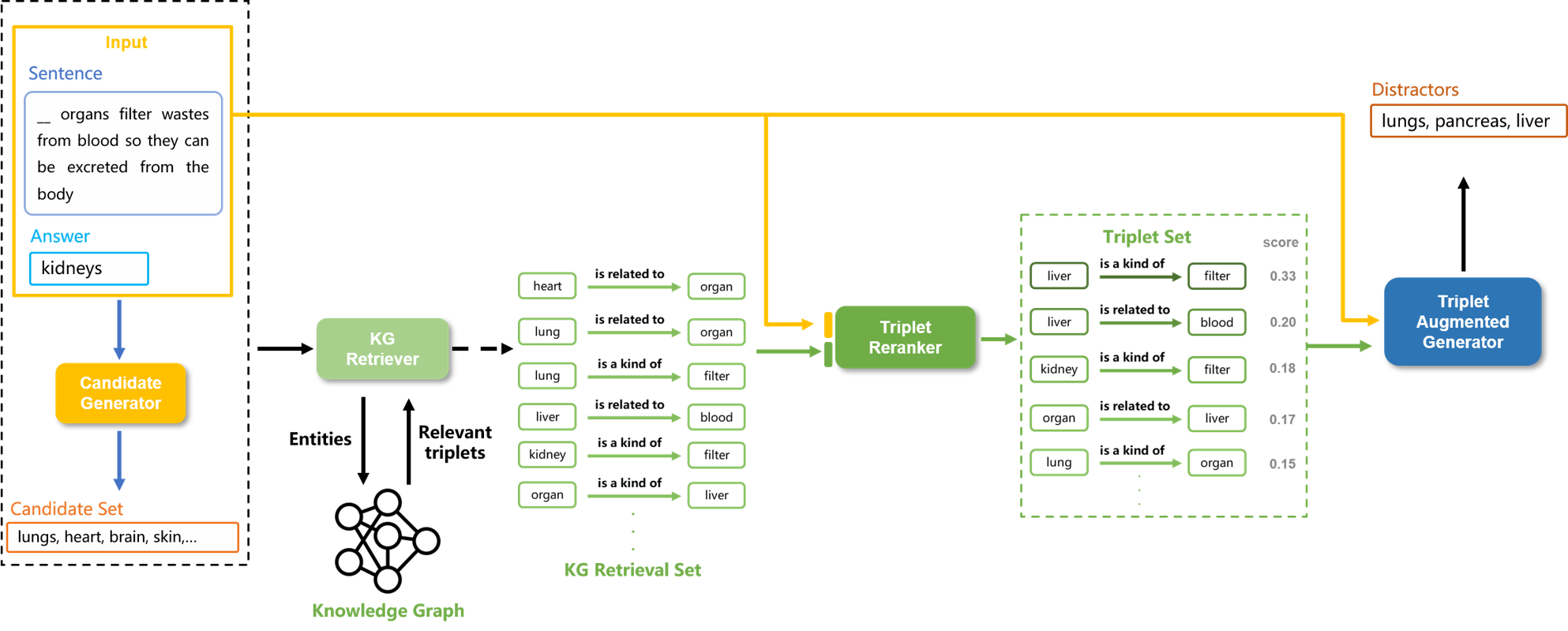This repo provides the source code & data of our paper : DG-KAG:Boosting Distractor Generation via Knowledge Triplet Augmentation.
Run the following commands to create a project environment (assuming CUDA10.1):
pip install torch==1.8.0+cu101 -f https://download.pytorch.org/whl/torch_stable.html
pip install transformers==3.4.0
pip install nltk spacy==2.1.6
python -m spacy download en
# for torch-geometric
pip install torch-scatter==2.0.7 -f https://pytorch-geometric.com/whl/torch-1.8.0+cu101.html
pip install torch-sparse==0.6.9 -f https://pytorch-geometric.com/whl/torch-1.8.0+cu101.html
pip install torch-geometric==1.7.0 -f https://pytorch-geometric.com/whl/torch-1.8.0+cu101.htmlWe use the distractor generation datasets (MCQ, Sciq) and the ConceptNet knowledge graph. Download all the raw data by
sh download_raw_data.sh
Preprocess the concept raw data by running
python preprocess_concept.py -p <num_processes>
The script will:
- Setup ConceptNet (e.g., extract English relations from ConceptNet, merge the original 42 relation types into 17 types)
Preprocess the MCQ and Sciq data by running
python preprocess_mcq.py -p <num_processes>
python preprocess_sciq.py -p <num_processes>
The script will:
- Identify all mentioned concepts in the questions and answers
Preprocess the MCQ and Sciq data by running
python retrieve_mcq_triplet.py
python retrieve_sciq_triplet.py
- Extract relevant triplet for each q-a pair and candidate set
The resulting file structure will look like:
.
├── README.md
├── data/
├── cpnet/ (prerocessed ConceptNet)
├── mcq/
├── train.json
├── valid.json
├── test.json
├── grounded/ (grounded entities)
├── candidate_set/ (candidate sets from candidate generator)
└── triplets/ (extracted triplets from kg retriever)
└── sciq/
├── modeling/ (train model)
├── KAG (KAG model)
├── mcq/
├── t5/
└── bart/
└── Reranker (Reranker model)
├── mcq/
└── sciq/
├── saved_models/
├── predictions/
├── eval/ (eval model predictions)
├── evaluate_mcq.py
└── evaluate_sciq.py
└── tutorial_material/ (some tutorial stuff)
For MCQ and Sciq, run juypter notebook in modeling folder
- Reranker : Model Training Juypter Notebook for KAG Component - Triplet Reranker
Using Triplet Reranker and KG Retrieval to Construct KAG
- KAG : Model Training Juypter Notebook for KAG
For MCQ and Sciq, run eval python file in eval folder
python eval_mcq.py --data_dir <prediction_file_path>
python eval_sciq.py --data_dir <prediction_file_path>
MCQ
| Trained model | Test F1@3 | Test NDCG@3 |
|---|---|---|
| T5 Triplet Augmentation | 16.47 | 30.99 |
Sciq
| Trained model | Test F1@3 | Test NDCG@3 |
|---|---|---|
| T5 Triplet Augmentation(with only answer triplet) | 16.50 | 32.39 |
Note: The models were trained and tested with HuggingFace transformers==3.4.0.
This repo is built upon the following work:
Scalable Multi-Hop Relational Reasoning for Knowledge-Aware Question Answering. Yanlin Feng*, Xinyue Chen*, Bill Yuchen Lin, Peifeng Wang, Jun Yan and Xiang Ren. EMNLP 2020.
https://github.com/INK-USC/MHGRN
QA-GNN: Question Answering using Language Models and Knowledge Graphs. Michihiro Yasunaga and Hongyu Ren and Antoine Bosselut and Percy Liang and Jure Leskovec. NAACL 2021.
https://github.com/michiyasunaga/qagnn
Many thanks to the authors and developers!
以上是這篇論文程式碼介紹 如果對於這個 Repo 有疑問的地方 或是 想與我更進一步的討論 歡迎寄信至 boy19990222@gmail.com.tw
- HankyStyle
- 范耀中教授
- 參考網站 : https://github.com/michiyasunaga/qagnn
